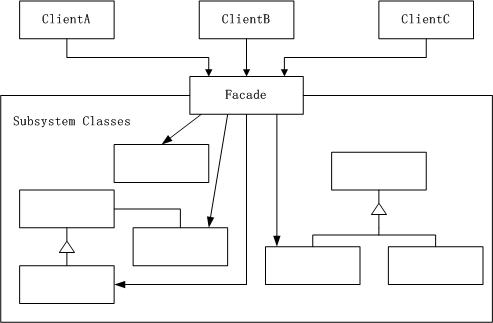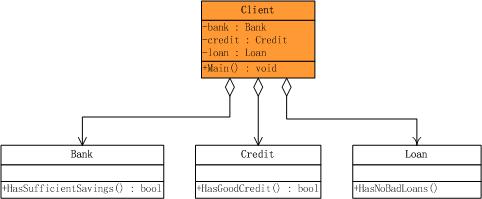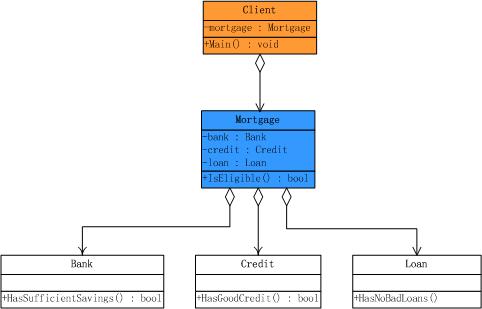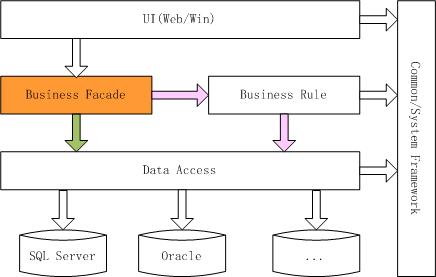外观模式(Façade Pattern)
——.NET设计模式系列之十二
Terrylee,2006年3月
概述
在软件开发系统中,客户程序经常会与复杂系统的内部子系统之间产生耦合,而导致客户程序随着子系统的变化而变化。那么如何简化客户程序与子系统之间的交互接口?如何将复杂系统的内部子系统与客户程序之间的依赖解耦?这就是要说的Façade 模式。
意图
为子系统中的一组接口提供一个一致的界面,Facade模式定义了一个高层接口,这个接口使得这一子系统更加容易使用。[GOF 《设计模式》]
示意图
门面模式没有一个一般化的类图描述,下面是一个示意性的对象图:

图1 Façade模式示意性对象图
生活中的例子
外观模式为子系统中的接口定义了一个统一的更高层次的界面,以便于使用。当消费者按照目录采购时,则体现了一个外观模式。消费者拨打一个号码与客服代表联系,客服代表则扮演了这个"外观",他包含了与订货部、收银部和送货部的接口。

图2使用电话订货例子的外观模式对象图
Facade模式解说
我们平时的开发中其实已经不知不觉的在用Façade模式,现在来考虑这样一个抵押系统,当有一个客户来时,有如下几件事情需要确认:到银行子系统查询他是否有足够多的存款,到信用子系统查询他是否有良好的信用,到贷款子系统查询他有无贷款劣迹。只有这三个子系统都通过时才可进行抵押。我们先不考虑Façade模式,那么客户程序就要直接访问这些子系统,分别进行判断。类结构图下:

图3
在这个程序中,我们首先要有一个顾客类,它是一个纯数据类,并无任何操作,示意代码:
 //
顾客类
//
顾客类
 public
class
Customer
public
class
Customer

 {
{ private string _name;
private string _name;
 public Customer(string name)
public Customer(string name)

 {
{ this._name = name;
this._name = name; }
}
 public string Name
public string Name

 {
{
 get
get  { return _name; }
{ return _name; } }
} }
}
下面这三个类均是子系统类,示意代码:
 //
银行子系统
//
银行子系统
 public
class
Bank
public
class
Bank

 {
{ public bool HasSufficientSavings(Customer c, int amount)
public bool HasSufficientSavings(Customer c, int amount)

 {
{ Console.WriteLine("Check bank for " + c.Name);
Console.WriteLine("Check bank for " + c.Name); return true;
return true; }
} }
}

 //
信用子系统
//
信用子系统
 public
class
Credit
public
class
Credit

 {
{ public bool HasGoodCredit(Customer c)
public bool HasGoodCredit(Customer c)

 {
{ Console.WriteLine("Check credit for " + c.Name);
Console.WriteLine("Check credit for " + c.Name); return true;
return true; }
} }
}

 //
贷款子系统
//
贷款子系统
 public
class
Loan
public
class
Loan

 {
{ public bool HasNoBadLoans(Customer c)
public bool HasNoBadLoans(Customer c)

 {
{ Console.WriteLine("Check loans for " + c.Name);
Console.WriteLine("Check loans for " + c.Name); return true;
return true; }
} }
}
来看客户程序的调用:
 //
客户程序
//
客户程序
 public
class
MainApp
public
class
MainApp

 {
{ private const int _amount = 12000;
private const int _amount = 12000;
 public static void Main()
public static void Main()

 {
{ Bank bank = new Bank();
Bank bank = new Bank(); Loan loan = new Loan();
Loan loan = new Loan(); Credit credit = new Credit();
Credit credit = new Credit();
 Customer customer = new Customer("Ann McKinsey");
Customer customer = new Customer("Ann McKinsey");
 bool eligible = true;
bool eligible = true;
 if (!bank.HasSufficientSavings(customer, _amount))
if (!bank.HasSufficientSavings(customer, _amount))

 {
{ eligible = false;
eligible = false; }
} else if (!loan.HasNoBadLoans(customer))
else if (!loan.HasNoBadLoans(customer))

 {
{ eligible = false;
eligible = false; }
} else if (!credit.HasGoodCredit(customer))
else if (!credit.HasGoodCredit(customer))

 {
{ eligible = false;
eligible = false; }
}
 Console.WriteLine("\n" + customer.Name + " has been " + (eligible ? "Approved" : "Rejected"));
Console.WriteLine("\n" + customer.Name + " has been " + (eligible ? "Approved" : "Rejected")); Console.ReadLine();
Console.ReadLine(); }
} }
}
可以看到,在不用Façade模式的情况下,客户程序与三个子系统都发生了耦合,这种耦合使得客户程序依赖于子系统,当子系统变化时,客户程序也将面临很多变化的挑战。一个合情合理的设计就是为这些子系统创建一个统一的接口,这个接口简化了客户程序的判断操作。看一下引入Façade模式后的类结构图:

图4
门面类Mortage的实现如下:
 //
外观类
//
外观类
 public
class
Mortgage
public
class
Mortgage

 {
{ private Bank bank = new Bank();
private Bank bank = new Bank(); private Loan loan = new Loan();
private Loan loan = new Loan(); private Credit credit = new Credit();
private Credit credit = new Credit();
 public bool IsEligible(Customer cust, int amount)
public bool IsEligible(Customer cust, int amount)

 {
{ Console.WriteLine("{0} applies for {1:C} loan\n",
Console.WriteLine("{0} applies for {1:C} loan\n", cust.Name, amount);
cust.Name, amount);
 bool eligible = true;
bool eligible = true;
 if (!bank.HasSufficientSavings(cust, amount))
if (!bank.HasSufficientSavings(cust, amount))

 {
{ eligible = false;
eligible = false; }
} else if (!loan.HasNoBadLoans(cust))
else if (!loan.HasNoBadLoans(cust))

 {
{ eligible = false;
eligible = false; }
} else if (!credit.HasGoodCredit(cust))
else if (!credit.HasGoodCredit(cust))

 {
{ eligible = false;
eligible = false; }
}
 return eligible;
return eligible; }
} }
}
顾客类和子系统类的实现仍然如下:
 //
银行子系统
//
银行子系统
 public
class
Bank
public
class
Bank

 {
{ public bool HasSufficientSavings(Customer c, int amount)
public bool HasSufficientSavings(Customer c, int amount)

 {
{ Console.WriteLine("Check bank for " + c.Name);
Console.WriteLine("Check bank for " + c.Name); return true;
return true; }
} }
}

 //
信用证子系统
//
信用证子系统
 public
class
Credit
public
class
Credit

 {
{ public bool HasGoodCredit(Customer c)
public bool HasGoodCredit(Customer c)

 {
{ Console.WriteLine("Check credit for " + c.Name);
Console.WriteLine("Check credit for " + c.Name); return true;
return true; }
} }
}

 //
贷款子系统
//
贷款子系统
 public
class
Loan
public
class
Loan

 {
{ public bool HasNoBadLoans(Customer c)
public bool HasNoBadLoans(Customer c)

 {
{ Console.WriteLine("Check loans for " + c.Name);
Console.WriteLine("Check loans for " + c.Name); return true;
return true; }
} }
}

 //
顾客类
//
顾客类
 public
class
Customer
public
class
Customer

 {
{ private string name;
private string name;
 public Customer(string name)
public Customer(string name)

 {
{ this.name = name;
this.name = name; }
}
 public string Name
public string Name

 {
{
 get
get  { return name; }
{ return name; } }
} }
}
而此时客户程序的实现:
 //
客户程序类
//
客户程序类
 public
class
MainApp
public
class
MainApp

 {
{ public static void Main()
public static void Main()

 {
{ //外观
//外观 Mortgage mortgage = new Mortgage();
Mortgage mortgage = new Mortgage();
 Customer customer = new Customer("Ann McKinsey");
Customer customer = new Customer("Ann McKinsey"); bool eligable = mortgage.IsEligible(customer, 125000);
bool eligable = mortgage.IsEligible(customer, 125000);
 Console.WriteLine("\n" + customer.Name +
Console.WriteLine("\n" + customer.Name + " has been " + (eligable ? "Approved" : "Rejected"));
" has been " + (eligable ? "Approved" : "Rejected"));  Console.ReadLine();
Console.ReadLine(); }
} }
}
可以看到引入Façade模式后,客户程序只与Mortgage发生依赖,也就是Mortgage屏蔽了子系统之间的复杂的操作,达到了解耦内部子系统与客户程序之间的依赖。
.NET架构中的Façade模式
Façade模式在实际开发中最多的运用当属开发N层架构的应用程序了,一个典型的N层结构如下:

图5
在这个架构中,总共分为四个逻辑层,分别为:用户层UI,业务外观层Business Façade,业务规则层Business Rule,数据访问层Data Access。其中Business Façade层的职责如下:
l 从“用户”层接收用户输入
l 如果请求需要对数据进行只读访问,则可能使用“数据访问”层
l 将请求传递到“业务规则”层
l 将响应从“业务规则”层返回到“用户”层
l 在对“业务规则”层的调用之间维护临时状态
对这一架构最好的体现就是Duwamish示例了。在该应用程序中,有部分操作只是简单的从数据库根据条件提取数据,不需要经过任何处理,而直接将数据显示到网页上,比如查询某类别的图书列表。而另外一些操作,比如计算定单中图书的总价并根据顾客的级别计算回扣等等,这部分往往有许多不同的功能的类,操作起来也比较复杂。如果采用传统的三层结构,这些商业逻辑一般是会放在中间层,那么对内部的这些大量种类繁多,使用方法也各异的不同的类的调用任务,就完全落到了表示层。这样势必会增加表示层的代码量,将表示层的任务复杂化,和表示层只负责接受用户的输入并返回结果的任务不太相称,并增加了层与层之间的耦合程度。于是就引入了一个Façade层,让这个Facade来负责管理系统内部类的调用,并为表示层提供了一个单一而简单的接口。看一下Duwamish结构图:

图6
从图中可以看到,UI层将请求发送给业务外观层,业务外观层对请求进行初步的处理,判断是否需要调用业务规则层,还是直接调用数据访问层获取数据。最后由数据访问层访问数据库并按照来时的步骤返回结果到UI层,来看具体的代码实现。
在获取商品目录的时候,Web UI调用业务外观层:
 productSystem
=
new
ProductSystem();
productSystem
=
new
ProductSystem(); categorySet
=
productSystem.GetCategories(categoryID);
categorySet
=
productSystem.GetCategories(categoryID);
业务外观层直接调用了数据访问层:
 public
CategoryData GetCategories(
int
categoryId)
public
CategoryData GetCategories(
int
categoryId)

 {
{ //
// // Check preconditions
// Check preconditions //
// ApplicationAssert.CheckCondition(categoryId >= 0,"Invalid Category Id",ApplicationAssert.LineNumber);
ApplicationAssert.CheckCondition(categoryId >= 0,"Invalid Category Id",ApplicationAssert.LineNumber); //
// // Retrieve the data
// Retrieve the data //
// using (Categories accessCategories = new Categories())
using (Categories accessCategories = new Categories())

 {
{ return accessCategories.GetCategories(categoryId);
return accessCategories.GetCategories(categoryId); }
}
 }
}
在添加订单时,UI调用业务外观层:
 public
void
AddOrder()
public
void
AddOrder()

 {
{ ApplicationAssert.CheckCondition(cartOrderData != null, "Order requires data", ApplicationAssert.LineNumber);
ApplicationAssert.CheckCondition(cartOrderData != null, "Order requires data", ApplicationAssert.LineNumber);
 //Write trace log.
//Write trace log. ApplicationLog.WriteTrace("Duwamish7.Web.Cart.AddOrder:\r\nCustomerId: " +
ApplicationLog.WriteTrace("Duwamish7.Web.Cart.AddOrder:\r\nCustomerId: " + cartOrderData.Tables[OrderData.CUSTOMER_TABLE].Rows[0][OrderData.PKID_FIELD].ToString());
cartOrderData.Tables[OrderData.CUSTOMER_TABLE].Rows[0][OrderData.PKID_FIELD].ToString()); cartOrderData = (new OrderSystem()).AddOrder(cartOrderData);
cartOrderData = (new OrderSystem()).AddOrder(cartOrderData); }
}
业务外观层调用业务规则层:
 public
OrderData AddOrder(OrderData order)
public
OrderData AddOrder(OrderData order)

 {
{ //
// // Check preconditions
// Check preconditions //
// ApplicationAssert.CheckCondition(order != null, "Order is required", ApplicationAssert.LineNumber);
ApplicationAssert.CheckCondition(order != null, "Order is required", ApplicationAssert.LineNumber);
 (new BusinessRules.Order()).InsertOrder(order);
(new BusinessRules.Order()).InsertOrder(order); return order;
return order; }
}
业务规则层进行复杂的逻辑处理后,再调用数据访问层:
 public
bool
InsertOrder(OrderData order)
public
bool
InsertOrder(OrderData order)

 {
{  //
// // Assume it's good
// Assume it's good //
// bool isValid = true;
bool isValid = true; //
//  // Validate order summary
// Validate order summary //
// DataRow summaryRow = order.Tables[OrderData.ORDER_SUMMARY_TABLE].Rows[0];
DataRow summaryRow = order.Tables[OrderData.ORDER_SUMMARY_TABLE].Rows[0];
 summaryRow.ClearErrors();
summaryRow.ClearErrors();
 if (CalculateShipping(order) != (Decimal)(summaryRow[OrderData.SHIPPING_HANDLING_FIELD]))
if (CalculateShipping(order) != (Decimal)(summaryRow[OrderData.SHIPPING_HANDLING_FIELD]))

 {
{ summaryRow.SetColumnError(OrderData.SHIPPING_HANDLING_FIELD, OrderData.INVALID_FIELD);
summaryRow.SetColumnError(OrderData.SHIPPING_HANDLING_FIELD, OrderData.INVALID_FIELD); isValid = false;
isValid = false; }
}
 if (CalculateTax(order) != (Decimal)(summaryRow[OrderData.TAX_FIELD]))
if (CalculateTax(order) != (Decimal)(summaryRow[OrderData.TAX_FIELD]))

 {
{ summaryRow.SetColumnError(OrderData.TAX_FIELD, OrderData.INVALID_FIELD);
summaryRow.SetColumnError(OrderData.TAX_FIELD, OrderData.INVALID_FIELD); isValid = false;
isValid = false; }
} //
//  // Validate shipping info
// Validate shipping info //
// isValid &= IsValidField(order, OrderData.SHIPPING_ADDRESS_TABLE, OrderData.SHIP_TO_NAME_FIELD, 40);
isValid &= IsValidField(order, OrderData.SHIPPING_ADDRESS_TABLE, OrderData.SHIP_TO_NAME_FIELD, 40); //
// // Validate payment info
// Validate payment info  //
// DataRow paymentRow = order.Tables[OrderData.PAYMENT_TABLE].Rows[0];
DataRow paymentRow = order.Tables[OrderData.PAYMENT_TABLE].Rows[0];
 paymentRow.ClearErrors();
paymentRow.ClearErrors();
 isValid &= IsValidField(paymentRow, OrderData.CREDIT_CARD_TYPE_FIELD, 40);
isValid &= IsValidField(paymentRow, OrderData.CREDIT_CARD_TYPE_FIELD, 40); isValid &= IsValidField(paymentRow, OrderData.CREDIT_CARD_NUMBER_FIELD, 32);
isValid &= IsValidField(paymentRow, OrderData.CREDIT_CARD_NUMBER_FIELD, 32); isValid &= IsValidField(paymentRow, OrderData.EXPIRATION_DATE_FIELD, 30);
isValid &= IsValidField(paymentRow, OrderData.EXPIRATION_DATE_FIELD, 30); isValid &= IsValidField(paymentRow, OrderData.NAME_ON_CARD_FIELD, 40);
isValid &= IsValidField(paymentRow, OrderData.NAME_ON_CARD_FIELD, 40); isValid &= IsValidField(paymentRow, OrderData.BILLING_ADDRESS_FIELD, 255);
isValid &= IsValidField(paymentRow, OrderData.BILLING_ADDRESS_FIELD, 255); //
// // Validate the order items and recalculate the subtotal
// Validate the order items and recalculate the subtotal //
// DataRowCollection itemRows = order.Tables[OrderData.ORDER_ITEMS_TABLE].Rows;
DataRowCollection itemRows = order.Tables[OrderData.ORDER_ITEMS_TABLE].Rows;
 Decimal subTotal = 0;
Decimal subTotal = 0;
 foreach (DataRow itemRow in itemRows)
foreach (DataRow itemRow in itemRows)

 {
{ itemRow.ClearErrors();
itemRow.ClearErrors();
 subTotal += (Decimal)(itemRow[OrderData.EXTENDED_FIELD]);
subTotal += (Decimal)(itemRow[OrderData.EXTENDED_FIELD]);
 if ((Decimal)(itemRow[OrderData.PRICE_FIELD]) <= 0)
if ((Decimal)(itemRow[OrderData.PRICE_FIELD]) <= 0)

 {
{ itemRow.SetColumnError(OrderData.PRICE_FIELD, OrderData.INVALID_FIELD);
itemRow.SetColumnError(OrderData.PRICE_FIELD, OrderData.INVALID_FIELD); isValid = false;
isValid = false; }
}
 if ((short)(itemRow[OrderData.QUANTITY_FIELD]) <= 0)
if ((short)(itemRow[OrderData.QUANTITY_FIELD]) <= 0)

 {
{ itemRow.SetColumnError(OrderData.QUANTITY_FIELD, OrderData.INVALID_FIELD);
itemRow.SetColumnError(OrderData.QUANTITY_FIELD, OrderData.INVALID_FIELD); isValid = false;
isValid = false; }
} }
} //
// // Verify the subtotal
// Verify the subtotal //
// if (subTotal != (Decimal)(summaryRow[OrderData.SUB_TOTAL_FIELD]))
if (subTotal != (Decimal)(summaryRow[OrderData.SUB_TOTAL_FIELD]))

 {
{ summaryRow.SetColumnError(OrderData.SUB_TOTAL_FIELD, OrderData.INVALID_FIELD);
summaryRow.SetColumnError(OrderData.SUB_TOTAL_FIELD, OrderData.INVALID_FIELD); isValid = false;
isValid = false; }
}
 if ( isValid )
if ( isValid )

 {
{ using (DataAccess.Orders ordersDataAccess = new DataAccess.Orders())
using (DataAccess.Orders ordersDataAccess = new DataAccess.Orders())

 {
{ return (ordersDataAccess.InsertOrderDetail(order)) > 0;
return (ordersDataAccess.InsertOrderDetail(order)) > 0; }
} }
} else
else return false;
return false; }
}
[MSDN]
效果及实现要点
1.Façade模式对客户屏蔽了子系统组件,因而减少了客户处理的对象的数目并使得子系统使用起来更加方便。
2.Façade模式实现了子系统与客户之间的松耦合关系,而子系统内部的功能组件往往是紧耦合的。松耦合关系使得子系统的组件变化不会影响到它的客户。
3.如果应用需要,它并不限制它们使用子系统类。因此你可以在系统易用性与通用性之间选择。
适用性
1.为一个复杂子系统提供一个简单接口。
2.提高子系统的独立性。
3.在层次化结构中,可以使用Facade模式定义系统中每一层的入口。
总结
Façade模式注重的是简化接口,它更多的时候是从架构的层次去看整个系统,而并非单个类的层次。
参考资料
Erich Gamma等,《设计模式:可复用面向对象软件的基础》,机械工业出版社
Robert C.Martin,《敏捷软件开发:原则、模式与实践》,清华大学出版社
阎宏,《Java与模式》,电子工业出版社
Alan Shalloway James R. Trott,《Design Patterns Explained》,中国电力出版社
MSDN WebCast 《C#面向对象设计模式纵横谈(11):Facade外观模式(结构型模式)》




















 625
625











 被折叠的 条评论
为什么被折叠?
被折叠的 条评论
为什么被折叠?








